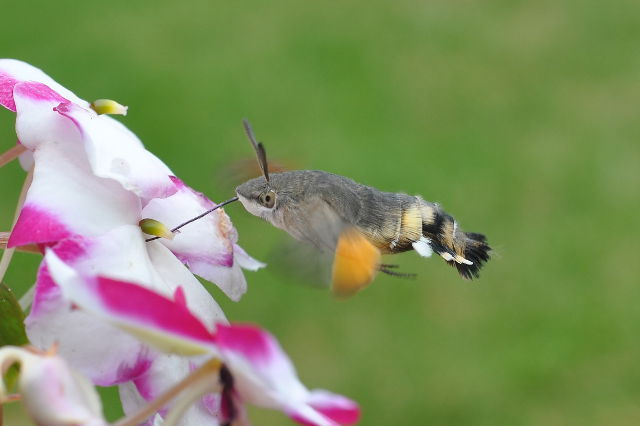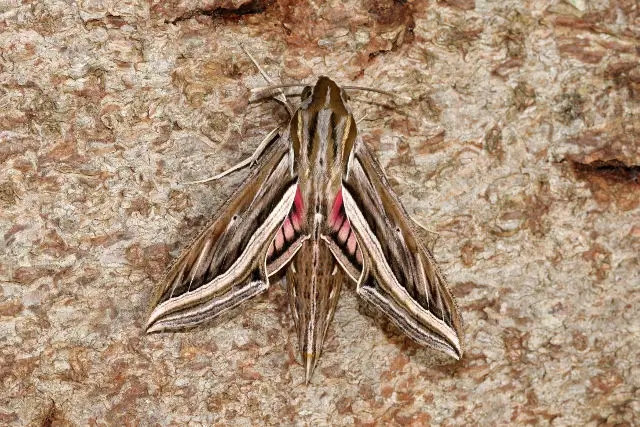Katie shares this latest news from Butterfly Conservation. Ed
Despite Christmas being weeks away, wildlife lovers will be gathered around the ivy over the coming nights as they search for rare and spectacular moths looking for an autumn lifeline.
An immigration of rare moths from Europe is currently taking place across the UK with the scarce Silver-striped Hawk-moth (pictured above) and Radford’s Flame Shoulder all seen in recent days.
Other visitors
These rarities have also been joined by spectacular immigrant species such as the giant Convolvulus Hawk-moth and Humming-bird Hawk-moth (pictured below).
The Clifden Nonpareil, one of the UK’s most striking autumn moths has recently become established from Dorset to Kent, but numbers have this year been boosted by dozens of immigrants from the continent.
Annual Moth Night Ivy provides a lifeline to moths, butterflies and other pollinators as it flowers late in the year when other nectar sources are unavailable.
Take a torchlight safari Many different autumnal moths are regularly seen refuelling on ivy blossom, including the beautiful Pink-barred Sallow, Angle Shades, Green-brindled Crescent, Yellow-line Quaker and Lunar Underwing.
Migrant species may be attracted too, such as the Silver Y, supping on the sugary nectar that will power their flights southwards to warmer climes.
Home-lovers All this insect activity has other benefits too – pollinating the ivy flowers will create the black berries that provide a winter food supply for birds. The pollinator nightshift “A quick check of ivy blossom on a sunny autumn day will reveal bees, hoverflies, butterflies and other insects, all making the most of this seasonal bonanza of nectar.
“After dark, the pollinator nightshift takes place and a myriad of moths come out to feed.
“For this year’s Moth Night, find some big patches of ivy flowers nearby and go back with a torch after the sun has set. It’s a fantastic and easy way to see some of the beautiful moths that are on the wing in autumn.” Ivy offers valuable nectar “Ivy is an undervalued natural resource and there is a tendency for it to be regarded as something that needs to be tidied away in the garden.
“However, ivy offers valuable nectar for insects, shelter for bats and nesting birds, as well as a source of berries for small mammals and birds. It is also an attractive plant in its own right.
“We are encouraging people to get out over the coming days and look at what they can see on their local ivy patches. Some of our most attractive autumnal moths may be glimpsed, taking advantage of this rich nectar source.” Important data “There are a fantastic range of autumnal moths in the UK, a number of which are declining. They provide food for many other animals especially those feeding up for winter when food is scarce.
“National Moth Night will provide important data to help determine the status of some of these species.” Moth night Image: © Butterfly Conservation / Roger Wasley
Image: © Bob Eade
As part of this year’s Moth Night, an annual UK-wide event to record moths, organisers Atropos, Butterfly Conservation and the Centre for Ecology & Hydrology are asking the public to investigate their local patches of flowering ivy to help gather more information on the plant’s importance to moths.
Over the next three nights wildlife lovers are being asked to take a torchlight safari of ivy flowers and count some of the moths that are on the wing in autumn.
For moths staying and overwintering as adults such as the Buttoned Snout and Red-green Carpet, ivy flowers provide an important food source as the moths build up their fat reserves.
Butterfly Conservation Head of Recording, Richard Fox said:
Atropos editor Mark Tunmore said:
Ecologist at CEH Marc Botham said
Moth Night 2017 runs from 12 to 14 October and will include moth trapping events across the UK.





